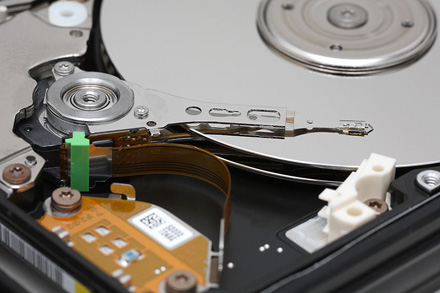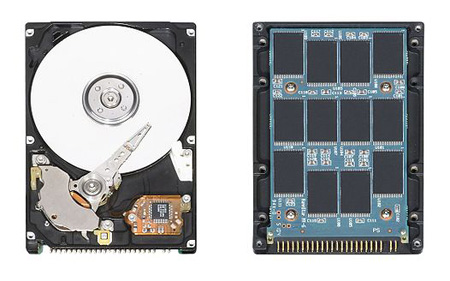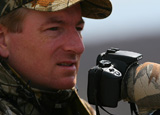
Having a backup plan in place is like having a bomb shelter. It might be inconvenient for a while but you will survive to live another day. Fortunately creating a backup strategy is much easier than making a bomb shelter. 🙂
A backup is simply one or more copies of your photos that are stored in a different place than your originals. It could be an external hard drive, a set of DVDs or an off-site data warehouse. The bottom line is that if your primary storage device fails, you will not lose your data.
Do you need more than one storage device?
You have just taken 3 gigabytes of photos and you’re about to upload them to your
computer. Where is the best place to store them? On the main drive with your operating system or on a separate drive?
Even large main drives are not big enough to keep the quantities of data we are adding to them. They will fill up quickly and that’s bad. If the drive with your operating system on it fills up, your system will slow down to a crawl, and eventually crash.
A secondary drive is essential for system stability. If you have a “tower” type system, you may be able to add one or more drives inside your computer.
Alternatively, you can add one or more external drives. An external drive has the added benefit of being portable. How you set up your drive will depend on what you are comfortable with. For most people, an external drive is the quickest and simplest way to additional storage.
USB, Firewire, Ethernet or eSATA?
![]()
Your computer may have USB, Firewire, Ethernet or eSATA connectors on it. Choosing the right connection for your external drive can make a big difference to the performance of your system.
For all practical purposes, there is little difference between USB 2.0 and Firewire 400. Firewire 400 is a little faster but most people won’t notice the difference. The older USB 1.0 is much slower and not recommended for external drives.
Firewire 800 is much faster than either USB or Firewire 400 and Gigabit Ethernet is even faster than Firewire 800 but is not as common and requires additional hardware such as a router or switch.
eSATA is the fastest of all current standards. eSATA drives and connectors are becoming more common and is a good choice if your system will support it. If you’re willing to spend the money and time to set it up, Gigabit Ethernet is a good option although its harder to get external drives with gigabit ethernet connections.
For most of us, USB 2.0 or Firewire 400 will do just fine and is easy to buy at good prices. If you edit video, you will need Firewire 800 or eSATA to support the high bandwidth of digital video.
Hard Disk or Solid State?

One of the simplest backup strategies is to add an external drive to your system and use a backup program to keep your backup current. Many hard drives now come with free backup software and there are also several professional software options available.
The two main types of hard drive are Hard Disk drives and Solid State drives. The hard disk drives contains a spinning disk and the Solid State drive contains no moving parts.
Solid State drives are much faster and less likely to crash from physical movement, but they also come with a much higher price tag.
If you move your drives around a lot, consider a Solid State Drive. If your system is set up at home, traditional drives are fine and generally far cheaper.
Methods of backing up
At this stage, let’s assume you have your main system drive and a second drive, either internal or external, that is your image storage drive. Right now, there is no backup for your data, so we need to come up with a strategy that will work for you.
The four main backup types we will discuss here are DVDs, Hard Drives, Backup
Appliances and Data Storage Centers. Which you choose will depend on your needs and your budget.
Just before we get into the backup types, let’s look briefly at the different methods of backup. The three methods are Unstructured, Incremental and Continuous.
An example of Unstructured backup is a collection of DVDs or CDs or even multiple small hard drives. Each backup is separate from the last and there is no single complete backup.
Incremental backups rely on having a complete original backup, then backing up the changes in data since the full backup.
Continuous backup maintains copies of your data in real-time on multiple disks, with an example of this being RAID technology.
Each method has advantages and disadvantages. DVDs will not keep any edits you make on your images but do a great job at keeping the original data intact. Incremental backups only backup what has changed since your last backup but until the backup is performed, anything that has changed since your last backup is not protected. However, you may be able to go back and retrieve a file that you accidentally deleted.
Continuous backup maintains your data in real-time, but if you delete a file accidentally, its gone forever. Continuous backups are always up-to-date and require little, if any, manual intervention.
The most secure backup is a combination of incremental and continuous, giving you up-to-the moment protection as well as the ability to retrieve files that were accidentally deleted. For most of us, this is impractical and costly but if you are a professional photographer or business owner, it may be right for you.
The final consideration is fire and theft. If the backup of your data is stolen or destroyed by fire, its gone forever. The safest backup is therefore an off-site backup as it protects against all possible data loss.
Stay tuned for Part 2 of this article which will discuss options for backing up your photos and recommend a few specific devices/services. To make sure you don’t miss it, sign up for free updates.
 About the Author: Matthew Fletcher has been a naturalist for over 30 years and is a self described “Tasmanian Devil.” Born in Tasmania, Australia, he has lived and worked in seven countries on three continents. Photography has always been a passion, and has enabled him to share his experiences through his images. These days you can find Matthew ‘down under’ hiking through the Tasmanian bush, so if you see him, stop & say G’Day.
About the Author: Matthew Fletcher has been a naturalist for over 30 years and is a self described “Tasmanian Devil.” Born in Tasmania, Australia, he has lived and worked in seven countries on three continents. Photography has always been a passion, and has enabled him to share his experiences through his images. These days you can find Matthew ‘down under’ hiking through the Tasmanian bush, so if you see him, stop & say G’Day.
This is a great start to the guide! I’m super paranoid about losing all of my photos, so I use a combination of backup systems. I have an external hard drive where I backup photos and files automatically every night. In additional to that, I periodically archive older photos to DVD and store them off-site. And as a last resort, my best photos get uploaded to the web in some form, so I’ll at least have those if everything else goes wrong!